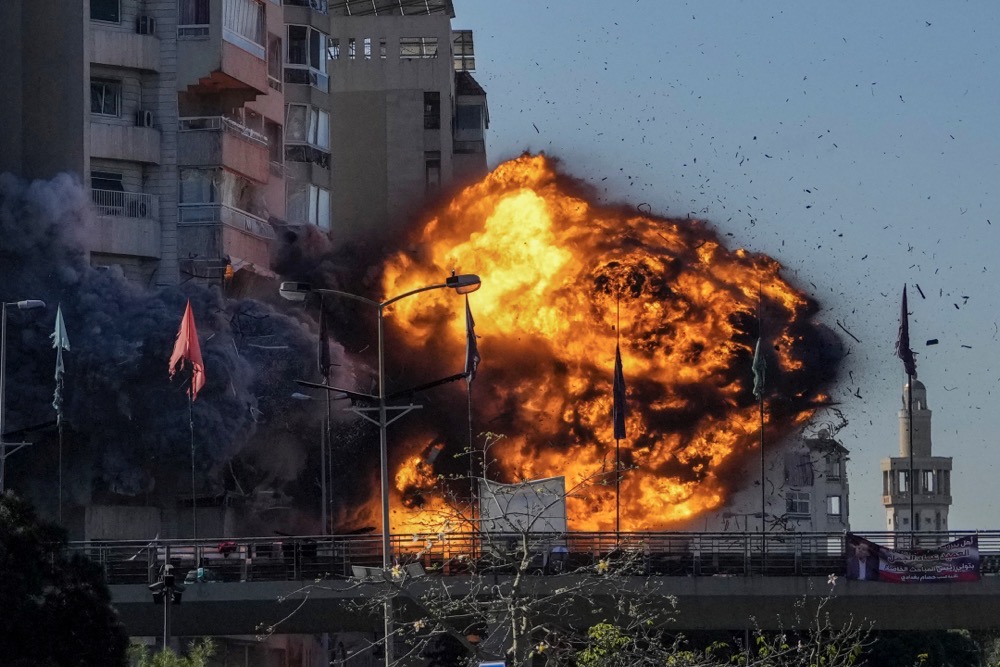LONDON: Since tensions between Israel and the Iran-backed Lebanese group Hezbollah flared up on Oct. 8 last year, paramedics and rescue workers in south Lebanon have found themselves in the line of fire, despite their protected status under international humanitarian law.
In the latest deadly incident, at least 13 people were killed on Thursday in an Israeli strike that hit the main civil defense center in the eastern Baalbek area, according to Lebanon’s General Directorate of Civil Defense.
Bachir Khodr, the regional governor, was quoted by BBC News as saying that the facility belonged to the Lebanese government and that among the victims was the city’s civil defense chief
In a post on X, EU High Representative Josep Borrell said the “EU strongly condemns” the loss of life and that the pattern of attack “mirrors appalling trends in other conflicts, from Syria to Ukraine or Sudan.”
As of Oct. 31, 2024, Israeli military strikes had killed at least 173 emergency workers, injured 277 others, and damaged 243 medical vehicles and 55 hospitals, according to Lebanon’s Ministry of Public Health.

Following the Oct. 7 Hamas-led attack on southern Israel that triggered the war in Gaza, Hezbollah began firing rockets into northern Israel in solidarity with its Palestinian ally. (AFP)
Humanitarian organizations and rights groups have joined the ministry in condemning attacks on first responders, their facilities, and ambulances.
“The killing of first responders in south Lebanon is a heartbreaking violation, not just of international law, but of basic humanity,” Tania Baban, the Lebanon country director of the US-based charity MedGlobal, told Arab News.
The media office of the Lebanese Civil Defense earlier shared with Arab News a list documenting 13 personnel and volunteers killed in Israeli strikes while performing their duties. The document, received on Nov. 13, detailed the victims’ names, positions and place of death.
Six of the deaths occurred in the southern governorate of Nabatieh, which has come under regular bombardment since mid-September, while six others occurred in the town of Dardaghia, east of Tyre, and one in Beirut’s southern suburbs.
An Israeli strike directly hit the civil defense center in Dardaghia on Oct. 9, leaving it “completely destroyed” and killing five of its staff, according to the organization’s media office.

Since the conflict began, at least 3,189 people — more than 770 of them women and children — have been killed. (AFP)
The document provided by the Lebanese Civil Defense also listed 70 personnel and volunteers injured in Israeli attacks while carrying out their duties. Injuries ranged in severity and included burns, head trauma, and inhalation of toxic fumes.
Lebanon’s Health Ministry condemned “the continued targeting of emergency medical teams by occupation forces,” calling on the international community “to put an end to this series of ongoing war crimes.”
The statement came after an airstrike on an ambulance in Zefta, a town in Nabatieh, reportedly killed a paramedic and injured two others on the morning of Oct. 31. According to the ministry, the vehicle belonged to the Al-Risala Emergency Medical Association.
“These are people who willingly risk their lives to help others, driven by a duty to save lives, often under extreme conditions. To see them become targets is devastating,” MedGlobal’s Baban said, referring to the first responders.
She said such attacks “undermine the very core of humanitarian work,” stressing that “medics are meant to be neutral, protected under international law.”
INNUMBERS
• 173+ First responders killed in Lebanon since October 2023.
• 243+ Emergency vehicles damaged across Lebanon.
• 55+ Healthcare facilities damaged.
(Source: Lebanese MOPH)
Indeed, Article 18 of the First Geneva Convention, Articles 16(1) and 17(1) of Protocol I, and Article 10(1) of Protocol II prohibit harming or punishing anyone performing medical activities, regardless of the person benefiting from them.
Human Rights Watch said in a statement on Oct. 30 that it had documented three direct Israeli attacks on “medical personnel, transports, and facilities” in Lebanon, which it said constituted “apparent war crimes.”
The three reported attacks involved a civil defense center in central Beirut on Oct. 3, as well as an ambulance and a hospital in southern Lebanon on Oct. 4, which killed 14 paramedics.

As of Oct. 31, 2024, Israeli military strikes had killed at least 173 emergency workers. (AFP)
In a statement on Oct. 11, Ravina Shamdasani, a spokesperson for the UN human rights office, said the conflict had killed more than 100 medics and emergency workers across Lebanon within the past year.
Jeanine Hennis-Plasschaert, the UN special coordinator for Lebanon, said at least “27 attacks targeted ambulances used by first responders” since early October last year.
Following the Oct. 7 Hamas-led attack on southern Israel that triggered the war in Gaza, Hezbollah began firing rockets into northern Israel in solidarity with its Palestinian ally. Israel retaliated, sparking a year-long exchange of fire along the shared Israel-Lebanon border.
However, this tit-for-tat suddenly escalated in September, with Israel mounting a wave of air and ground attacks against Hezbollah’s communications network, weapons caches, and leadership, eliminating the group’s secretary-general Hassan Nasrallah on Sept. 27.
Residential buildings in Beirut’s southern suburbs have not been spared, nor have villages in south Lebanon, including Ayta Al-Shab, Ramyeh, Kfar Kila, and Mhaybib, according to an analysis of satellite data by The Washington Post.
Some 1.2 million people have been displaced from southern and eastern Lebanon, according to UN figures. As of Oct. 12, more than 283,000 of them — most of them Syrian nationals — had crossed the border into war-torn Syria.
Since the conflict began, at least 3,189 people — more than 770 of them women and children — have been killed, while some 14,078 others have been wounded, according to the Ministry of Public Health.

A document provided by the Lebanese Civil Defense also listed 70 personnel and volunteers injured in Israeli attacks while carrying out their duties. (AFP)
In Israel, 72 people have been killed by Hezbollah attacks, including 30 soldiers, according to the prime minister’s office. More than 60,000 people have been displaced from their homes.
The Israeli military has not denied targeting ambulances in south Lebanon, a Hezbollah stronghold that has become a battleground between Israeli forces and Lebanese and Palestinian armed groups. On Oct. 12, it even threatened to target medical vehicles.
Avichay Adraee, the Israeli army’s Arabic-speaking spokesperson, said: “Hezbollah operatives are using ambulances to transport fighters and arms.”
In a post on the social media platform X on Oct. 12, he warned that “action will be taken (by the Israeli military) against any vehicle carrying armed men, regardless of its type.”

Israel mounting a wave of air and ground attacks against Hezbollah’s communications network, weapons caches, and leadership. (AP)
Prior to Adraee’s statement, on Oct. 3, the UK’s Guardian newspaper reported that Israel had struck a civil defense center in central Beirut belonging to the Islamic Health Committee, which is affiliated with Hezbollah.
The following day, the BBC reported that an Islamic Health Committee ambulance was struck near the entrance of Marjayoun Hospital in southern Lebanon, killing seven paramedics and forcing the facility to close.
Human Rights Watch said in its Oct. 30 statement that “membership or affiliation with Hezbollah, or other political movements with armed wings, is not a sufficient basis for determining an individual to be a lawful military target.”
“Medical personnel affiliated with Hezbollah, including those assigned to civil defense organizations, are protected under the laws of war,” the rights monitor added.

Article 18 of the First Geneva Convention, Articles 16(1) and 17(1) of Protocol I, and Article 10(1) of Protocol II prohibit harming or punishing anyone performing medical activities. (AFP)
It called on the Israeli military to “immediately halt unlawful attacks on medical workers and health care facilities,” urging Israel’s allies to “suspend the transfer of arms to Israel given the real risk that they will be used to commit grave abuses.”
MedGlobal’s Baban said the targeting of first responders in Lebanon “leaves communities even more vulnerable, depriving families and neighborhoods of essential care and support at a time when they need it most.”
“Every attack on medical staff not only steals lives but shakes the hope and resilience of those they serve,” she said. “We must continue to demand respect and safety for all who work to heal and protect in these conflict zones.”




























